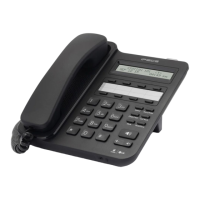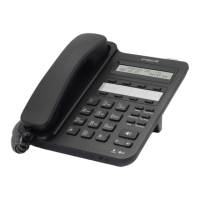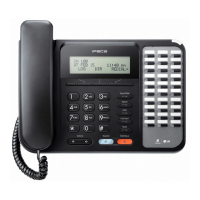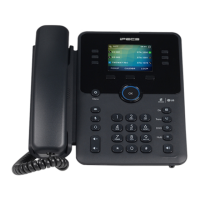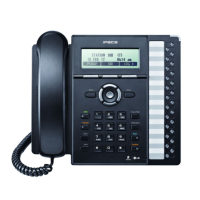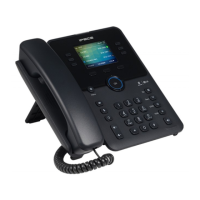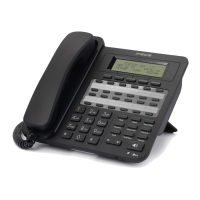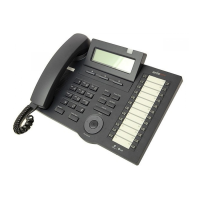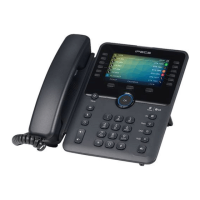Do you have a question about the LG-Ericsson iPECS LDP-9208D and is the answer not in the manual?
General overview of the telephone system and its capabilities.
Information on how the user guide is structured to explain features.
Explanation of how features are organized logically for easy location.
Step-by-step guide for installing a DSS console onto LDP-9200 series phones.
Instructions for connecting the handset, ear mic, and line cable to the phone.
Guidance on headset compatibility and where to find the list.
How to access and navigate the phone's display menu for various functions.
Details on accessing the Attendant menu, its availability, and requirements.
How to answer different types of incoming calls when the phone is idle.
How to handle incoming calls when already on another call (Call Waiting).
Guide to using the AME feature for screening calls and managing messages.
How to use different ring tones to differentiate incoming calls.
How to answer calls in Night mode using Universal Night Answer.
Procedures for answering calls ringing at other stations or groups.
How to activate DND to block incoming calls and its effects.
Instructions for diverting calls to other stations or voicemail systems.
How to place calls to other stations within the system using the intercom.
Procedure for waiting for a busy station to become available or requesting a callback.
How to leave a message wait indication for a called user who is unavailable.
Instructions for placing outgoing calls via CO/IP lines using buttons or dial codes.
Instructions for placing outgoing calls via CO/IP lines using buttons or dial codes.
How to request notification when a busy CO/IP line becomes available.
How to use account codes for tracking and billing external calls.
How to temporarily lock the phone by activating Temporary COS to disable dialing.
How to activate Walking COS to override dialing restrictions for a single call.
Accessing phone directories (Station, Public, LDAP) for dialing numbers.
How to redial the last dialed or received number from the call log.
How to store and dial numbers from the Saved Number Dial buffer.
How to place calls using pre-programmed system speed dial numbers.
How to enter and use station-specific speed dial numbers and names.
How to set up automatic retries for busy or unanswered external calls.
How to transfer an active call to another station or resource, screened or unscreened.
How to place active calls on hold, distinguishing between System and Exclusive Hold.
How to switch between active and held calls, acting as a broker.
How to create and configure conference rooms with optional passwords for invited parties.
How to create and configure conference rooms with optional passwords for invited parties.
How to park an active call and notify a user via paging.
How to record conversations on the phone, including administrative checks.
How to respond to message waiting indicators and review different message types.
Accessing and managing voice messages, including remote control of call forwarding.
How to exchange short text messages (SMS) with other users on the phone.
How remote users can access system resources like making calls or checking voicemails.
How to register, activate, and use a mobile phone as an extension of the iPECS system.
How to view logs of received, dialed, and lost calls on the phone's display.
How background music and music on hold are provided and managed.
How to broadcast announcements to internal and external paging zones.
How to log in/out of PTT groups and make one-way page announcements.
Setting up and using the station's alarm clock feature for daily or one-time alarms.
How the system monitors external alarm and door bell contacts.
How the system operates during power outages using backup batteries or PFT.
Information provided by system voice memos, such as station status and date/time.
How to access PBX or Centrex services through CO lines and feature codes.
How to use the Keypad facility to send dialed digits as data for ISDN services.
How to use the Keypad facility to send dialed digits as data for ISDN services.
How to access ISDN supplementary services like call hold and conferencing.
How to restrict the transmission of Caller ID for outgoing calls.
How to assign station attributes like authorization codes using program codes.
Guide on assigning features and functions to Flex buttons for one-touch activation.
General overview of the telephone system and its capabilities.
Information on how the user guide is structured to explain features.
Explanation of how features are organized logically for easy location.
Step-by-step guide for installing a DSS console onto LDP-9200 series phones.
Instructions for connecting the handset, ear mic, and line cable to the phone.
Guidance on headset compatibility and where to find the list.
How to access and navigate the phone's display menu for various functions.
Details on accessing the Attendant menu, its availability, and requirements.
How to answer different types of incoming calls when the phone is idle.
How to handle incoming calls when already on another call (Call Waiting).
Guide to using the AME feature for screening calls and managing messages.
How to use different ring tones to differentiate incoming calls.
How to answer calls in Night mode using Universal Night Answer.
Procedures for answering calls ringing at other stations or groups.
How to activate DND to block incoming calls and its effects.
Instructions for diverting calls to other stations or voicemail systems.
How to place calls to other stations within the system using the intercom.
Procedure for waiting for a busy station to become available or requesting a callback.
How to leave a message wait indication for a called user who is unavailable.
Instructions for placing outgoing calls via CO/IP lines using buttons or dial codes.
Instructions for placing outgoing calls via CO/IP lines using buttons or dial codes.
How to request notification when a busy CO/IP line becomes available.
How to use account codes for tracking and billing external calls.
How to temporarily lock the phone by activating Temporary COS to disable dialing.
How to activate Walking COS to override dialing restrictions for a single call.
Accessing phone directories (Station, Public, LDAP) for dialing numbers.
How to redial the last dialed or received number from the call log.
How to store and dial numbers from the Saved Number Dial buffer.
How to place calls using pre-programmed system speed dial numbers.
How to enter and use station-specific speed dial numbers and names.
How to set up automatic retries for busy or unanswered external calls.
How to transfer an active call to another station or resource, screened or unscreened.
How to place active calls on hold, distinguishing between System and Exclusive Hold.
How to switch between active and held calls, acting as a broker.
How to create and configure conference rooms with optional passwords for invited parties.
How to create and configure conference rooms with optional passwords for invited parties.
How to park an active call and notify a user via paging.
How to record conversations on the phone, including administrative checks.
How to respond to message waiting indicators and review different message types.
Accessing and managing voice messages, including remote control of call forwarding.
How to exchange short text messages (SMS) with other users on the phone.
How remote users can access system resources like making calls or checking voicemails.
How to register, activate, and use a mobile phone as an extension of the iPECS system.
How to view logs of received, dialed, and lost calls on the phone's display.
How background music and music on hold are provided and managed.
How to broadcast announcements to internal and external paging zones.
How to log in/out of PTT groups and make one-way page announcements.
Setting up and using the station's alarm clock feature for daily or one-time alarms.
How the system monitors external alarm and door bell contacts.
How the system operates during power outages using backup batteries or PFT.
Information provided by system voice memos, such as station status and date/time.
How to access PBX or Centrex services through CO lines and feature codes.
How to use the Keypad facility to send dialed digits as data for ISDN services.
How to use the Keypad facility to send dialed digits as data for ISDN services.
How to access ISDN supplementary services like call hold and conferencing.
How to restrict the transmission of Caller ID for outgoing calls.
How to assign station attributes like authorization codes using program codes.
Guide on assigning features and functions to Flex buttons for one-touch activation.
| Type | Digital Phone |
|---|---|
| Line Keys | 8 |
| Speakerphone | Yes |
| Headset Port | Yes |
| Wall Mountable | Yes |
| Speed Dial | Yes |
| Handset | Standard |
| Volume Control | Yes |
| Compatibility | iPECS Systems |
